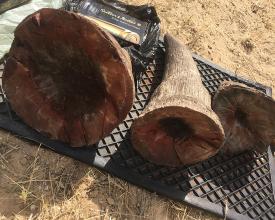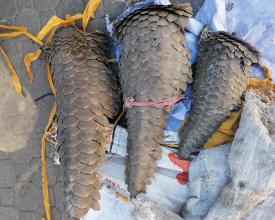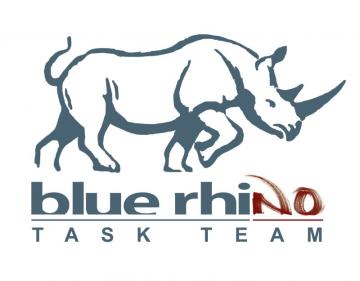
Countering poaching and trafficking of illegal wildlife products to support biodiversity protection through Operation Blue Rhino
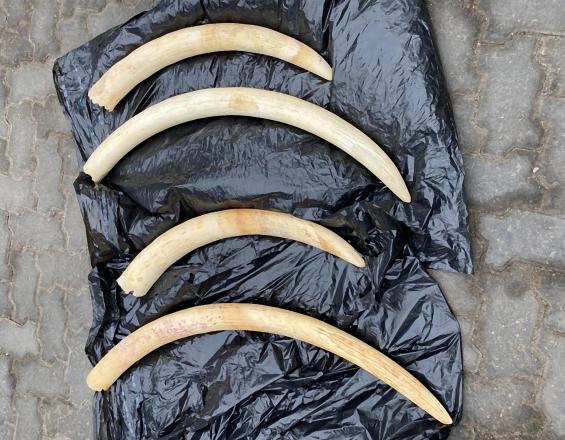
Operation Blue Rhino was initiated in 2018 to counter the surge in high-value wildlife crime in Namibia. The formal cooperation between government ministries is enabled through external funding support. Blue Rhino is facilitated through active collaboration amongst numerous partner organisations. Effective conservation systems that enable healthy wildlife populations form the foundation of biodiversity protection in Namibia. Anti-poaching initiatives guard against criminal impacts on vulnerable wildlife. Law enforcement and prosecution thwart criminal activities to safeguard national objectives. Operation Blue Rhino works within this framework to eradicate commercial poaching and trafficking of illegal wildlife products, thus supporting the protection of Namibia’s biodiversity. The operation is run by a dedicated task force, the Blue Rhino Task Team, made up of police investigators and conservation personnel. Operation Blue Rhino builds on the foundations and ongoing efforts of regional police and conservation units.
Context
Challenges addressed
During the past decade Namibia faced escalating wildlife crime, particularly targeting high-value species such as elephant, black and white rhinos, and pangolin. The years 2015/16 saw peaks in elephant and rhino poaching. Namibia’s sound conservation systems and healthy wildlife populations limited the impacts, yet poaching threatened vulnerable rhino populations distributed across state, community and private conservation areas. Some small, isolated rhino populations were completely wiped out. This affected the tourism and conservation-hunting industries, and rural livelihoods. The cost of protecting rhinos against poachers threatened to make private reserves economically unviable. The Namibian government worked with NGOs, the private sector and local communities to reverse this trend. National security forces have been deployed to national parks in an anti-poaching capacity since 2016. Since 2018, wildlife-crime law enforcement has been significantly transformed through the work of Operation Blue Rhino.
Location
Process
Summary of the process
The Namibian government is mandated with the protection of the country’s biodiversity, the enforcement of its laws, the defence of the state and its resources against threats, and numerous other activities related to wildlife protection and law enforcement. To be effective in the long term, efforts to counter wildlife crime must work directly through mandated government agencies. Here, interagency cooperation forms the vital foundation for successful interventions. Direct, fast and flexible external funding can bridge funding gaps and remove bureaucratic obstacles within government to unlock the full potential of staff to effectively carry out their mandated conservation and law-enforcement activities. The use of all available technologies and tools provides an operational edge, while strategic planning and innovative action ensure that efforts are focussed and coordinated, and that activities can adapt to change as required.
Criminals have an advantage in that they can operate beyond all boundaries without rules or regulations, strike quickly when it suits them, and receive direct, often significant rewards. Through the interaction of the described building blocks, conservation and law-enforcement interventions can gain the upper hand over criminals.
Building Blocks
Interagency cooperation
Government agencies often work in isolation from other government agencies, as well as from non-governmental organisations, private-sector entities, local communities and other potential partners. Interagency cooperation ensures that separate agencies with overlapping mandates or interests liaise and collaborate with each other to address common goals. The Ministry of Environment, Forestry and Tourism is the custodian of wildlife and other terrestrial resources in Namibia, mandated with their conservation and protection. The Namibian Police Force is mandated with maintaining law and order, including laws related to wildlife. The Namibian Defence Force is tasked with defending the state and its resources against threats. The Office of the Prosecutor General is responsible for prosecuting suspects in the name of the state in criminal proceedings. Other government agencies with some overlapping mandate include the Directorate of Customs and Excise, the Financial Intelligence Centre and the Anti-Corruption Commission. Government actions can be considerably strengthened through partnerships with NGOs, the private sector, local communities and international funding agencies. Active collaboration between government agencies, and between government and other stakeholders, facilitates effective countering of wildlife crime in Namibia.
Enabling factors
- Full commitment by all levels of government
- Clear agency mandates with common goals
- Active & ongoing communication & sharing of resources
- Strong working relationships between key individuals
- Trust in the integrity & competence of individuals & organisations
- Full recognition of individual contributions
- Recognition of defined roles at individual & organisational levels
- Capacity building & empowerment at all levels
- Fast & flexible external funding & technical support
- Stakeholder recognition & support of government mandates
Lesson learned
- Interagency cooperation must be formalised through written memorandums outlining aims
- Interagency cooperation requires clear structures, chains of command & mutual trust
- Roles and responsibilities at individual & organisational levels must be clearly defined
- While working together, each agency must remain within & fulfil the requirements of its particular mandate
- Overreach of agencies or individuals must be avoided
- Effective cooperation is built through active, ongoing liaison between key individuals of different entities
- Funding & capacity limitations of government must be overcome
- Fast & flexible external funding support directly to government law-enforcement operations unlocks full potential & motivates individuals
- A healthy mix of support from international funding agencies & local funding sources that bridges government gaps is ideal
- Full recognition of all contributions is vital for broad engagement & support
- Active communication & sharing of data & resources is vital for success
- Sharing of resources between units is built on a foundation of trust
Direct, fast and flexible external funding support for law enforcement and related needs
A large portion of international funding support to counter wildlife crime is used for workshops and conferences, awareness creation and community mobilisation, general equipment and infrastructure, and implementing-NGO overheads. The terms of use for such funding are often dictated by the funding agency and the implementing NGO, rather than the government of the target country. While these interventions play an important role, they generally do not directly address the core challenge of countering wildlife crime. Government agencies often operate on limited budgets with restrictive procurement and approval procedures. This can inhibit rapid action, particularly in unforeseen crisis scenarios. Fast and flexible external funding support that is channelled directly into government operations can remove many of these constraints and unlock the full potential of government staff. In the context of countering wildlife crime, this enables government law-enforcement and conservation personnel to respond rapidly to incidents of any nature and effectively carry out their mandated duties. Importantly, funds must be channelled directly into operational activities, ideally via a local support NGO with minimal overheads, rather than becoming part of broader budgets that are prone to bureaucratic pitfalls.
Enabling factors
- Government willingness to receive direct external funding support for wildlife protection & law enforcement activities
- International funding agency with flexible funding parameters
- Local support NGO trusted by government & with proven track record in countering wildlife crime to act as conduit for funding with minimal overheads
- Capacity building & individual empowerment of government law-enforcement & conservation personnel to enable them to effectively carry out mandated duties
Lesson learned
- A trusted local support NGO, with experience & understanding of the operational environment is important to secure international funding & channel this into priority government operations
- Funding must be disbursed directly to mandated government activities for wildlife protection & law enforcement
- Funding must be able to be disbursed as needed, 24 hours a day 365 days a year, to ensure rapid response capabilities at all times
- Small pilot initiatives are valuable in testing systems & approaches
- Strong relationships between key personnel are vital in achieving desired results
Use of all available technologies and tools
Criminals constantly adapt their activities to changing circumstances. It is therefore vital that activities to counter crime also adapt. A great variety of modern technologies exist that can significantly enhance initiatives to counter wildlife crime. These can be combined with a range of traditional and novel conservation and law-enforcement tools to provide an operational edge over criminal activities. Constant innovation in the development of technologies and tools requires regular updating to keeping abreast of changes. It is also possible to modify both technologies and tools at a local level to suit unique requirements and applications as these arise.
In the law-enforcement sphere related to wildlife crime, vital technology categories include surveillance, forensics (DNA, ballistics, digital), data capture/management/analysis, and more. Tools include information networks, investigative techniques, prosecution techniques, court-case monitoring, legislative options, and more.
The effective application of these technologies and tools requires capacity building within government, as well as the empowerment of individual staff to apply the technologies and tools as needed.
Enabling factors
- Government parameters to effectively implement the use of available technologies & tools
- Funding to secure the latest technologies & tools & update these as required
- Capacity building to ensure technologies & tools are used to best effect
Lesson learned
- Technologies & tools are only valuable if they can be applied by competent, dedicated personnel
- Technologies & tools must be shared amongst all relevant stakeholders to ensure best application
- Relationship building amongst personnel from all relevant agencies is important to ensure that technologies & tools are embraced by all relevant actors
- Elitist attitudes to the use of technologies & tools are often counterproductive
- The capacity to adapt technologies and tools to local needs & circumstances can be a game changer
Strategic planning and innovative action
In the longer term, interventions to counter wildlife crime can only be effective if they are based on a combination of strategic planning and innovative action. Practical strategies with clearly defined aims are vital to enable coordinated interventions. All interventions must seek to achieve required outcomes that work towards priority goals. To be successful, strategic planning – as well as the resultant interventions – must involve all key role players to ensure a sense of joint ownership. Similarly, strategic interventions must embrace the contributions of all relevant stakeholders to ensure coordinated action. Yet action must remain innovative so that activities can be adapted as unforeseen circumstances are encountered, new needs arise, or parameters shift. In addition, strategies need to be revisited and refined at regular intervals to ensure they remain relevant in a changing environment. This combination of working toward clear aims with effective strategies, while always being willing and able to adapt through innovative changes in approach and action, is an essential building block to effectively counter wildlife crime.
Enabling factors
- Sound systems & approaches must be in place to create an effective framework for strategic planning and innovative action
- All stakeholders must be involved in strategic planning to ensure a sense of joint ownership & enable successful implementation
- A strong partnership between conservation & law-enforcement agencies is vital for coordinated strategies to counter wildlife crime
- Clearly defined overall aims & required outcomes enable strategic planning to be relevant and implementable
Lesson learned
- Strategies are only successful if they are embraced by all key stakeholders & can be implemented effectively
- Strategies must be realistic, practical and achievable
- Acknowledgement of all contributions to the implementation of a strategy is important
- Strategies must be revisited & refined regularly to remain relevant
- Innovation & adaptability to change strategies as needs dictate is vital for ongoing success
- Existing systems & approaches may need to be revised to enable the implementation of strategies, or to ensure innovation & adaptability
Impacts
During the first three years of Operation Blue Rhino wildlife-crime law enforcement in Namibia shifted from reactive to proactive action. Surveillance, analytics and other technological capabilities and related information networks were vastly improved. Early detection of criminal activity has enabled pre-emptive arrests and rapid responses to incidents. Systematic investigations continue to produce results in old cases, with perpetrators still being arrested years after incidents. The swift arrest of insiders, including members of Namibia’s security forces who have become involved in wildlife crime, has made it clear that nobody is above the law. Improved case management, court preparation and court monitoring have resulted in increased conviction rates and more appropriate penalties. These interventions have transformed wildlife-crime law enforcement in Namibia. Results include:
- law enforcement pro-active & evidence-led
- data from relevant agencies consolidated, managed & analysed via integrated wildlife-crime database
- effective information networks created
- arrests & seizures significantly increased
- pre-emptive arrests saving numerous rhinos
- high-level dealers & kingpins arrested
- active collaboration with Environmental Crimes Unit, Office of the Prosecutor General, significantly strengthening prosecution
- poaching of elephant & rhinos significantly reduced
- ongoing capacity building of personnel
Beneficiaries
- Biodiversity of Namibia
- Elephant, rhino & pangolin populations
- People of Namibia
- Government of Namibia
- Tourism industry
- Conservation-hunting industry
- State, community and private protected areas
- Southern African anti-trafficking initiatives
Sustainable Development Goals
Story
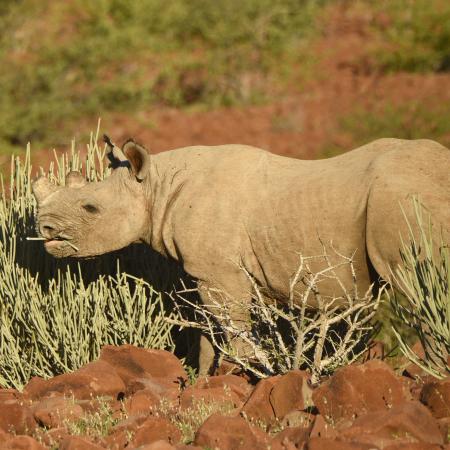
Pre-emptive arrests of would-be rhino poachers are amongst the most personally satisfying and inspiring of all Blue Rhino interventions. They present one of the best law-enforcement outcomes related to rhino poaching and trafficking that one can hope for. In recent years, pre-emptive law enforcement has been a game-changer in countering rhino crimes and facilitating the protection of Namibia’s rhino populations. Between the beginning of 2018 and the end of 2021, 42 pre-emptive cases related to rhinos have led to the arrest of 161 suspects. These are impressive law-enforcement results. They are also extremely important conservation outcomes.
Pre-emptive arrests apprehend perpetrators while they are planning or attempting to carry out a crime, but have not yet been able to kill an animal. The arrests are saving numerous rhinos, yet are still apprehending and convicting perpetrators – a significant deterrent to further poaching. The knock-on effect of the disruption of entire trafficking syndicates means that a considerable number rhinos are saved through each pre-emptive arrest. The result is a combination of law-enforcement successes and positive conservation outcomes.
At the beginning of the poaching surge in Namibia, law enforcement was mostly carried out in reaction to the discovery of dead animals, or the opportunistic seizure of wildlife products. Through proactive investigations, interagency cooperation, fast and flexible funding, use of the latest surveillance and analytical technology, and community information and support, poachers are now regularly being arrested and charged with conspiracy to poach before they manage to kill a rhino. Arresting perpetrators while at the same time keeping rhinos safe is a particularly satisfying personal achievement for law enforcement and conservation personnel.
Under Namibian legislation, the laws and penalties regarding the conspiracy to commit an offence (in this case rhino poaching) are applied in the same manner as if the perpetrator had committed the actual offence. Suspects in pre-emptive arrests are charged with conspiracy to poach rhino (also known as intent to poach). Charges in pre-emptive arrest cases are based on a variety of incriminating evidence, which may include unlawful entry into a game park, possession of illegal firearms, carrying of firearms in a game park etc. Importantly, the sentences handed down by the courts must recognise the severity of the offences as being on par with actual poaching.

